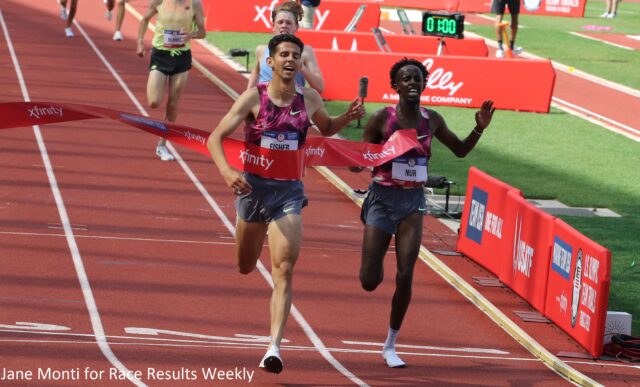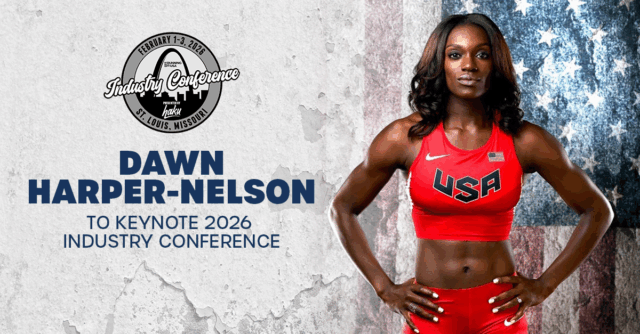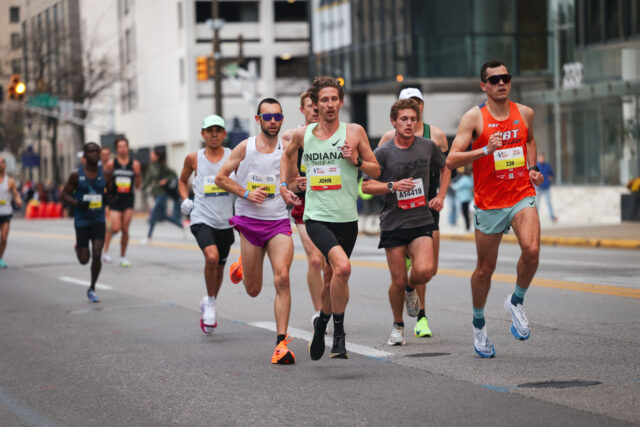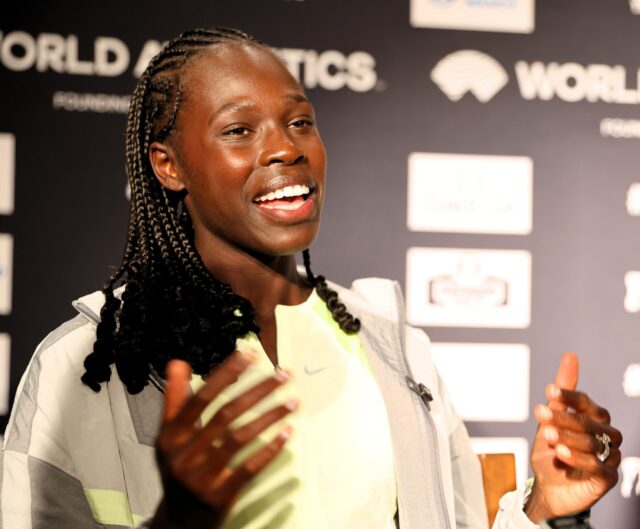Midsize Business

Historic Men's 5000m On Tap At USATF Championships
(c) 2025 Race Results Weekly, all rights reserved. Published with permission.
EUGENE (30-Jul) -- While American middle distance running has garnered a lot of attention over the last two seasons punctuated by a gold medal and Olympic record for Cole Hocker at the 2024 Paris Olympics in the 1500m, athletes in the 5000m have this season brought the longer event to a new zenith. So far this year five American men --Grant Fisher, Nico Young, Graham Blanks, Cooper Teare, and Cole Hocker-- have broken 13 minutes. Five of the six-fastest USA marks in history have been set this year, and Fisher (12:44.09) and Young (12:45.27) have run national records indoors and outdoors, respectively (Fisher has the absolute record).
"The sport, especially in the U.S., has grown leaps and bounds in the last decade or so," Fisher told reporters here at a press conference in advance of the four-day Toyota USATF Outdoor Track & Field Championships at Hayward Field at the University of Oregon. "You look at the all-time marks now. We've had three guys break 12:50 in one year, whereas in the past you might have one guy that would break 13:00 every other year. The depth is increasing a ton."
That depth will be on full display on Sunday afternoon when approximately 25 men will line up for a straight final in which the top three will provisionally qualify for the World Athletics Championships in Tokyo in September. At last year's Olympic Trials, also held here in Eugene, a field of 30 athletes was first narrowed down to 16 through two preliminary heats. This year's race will more closely resemble a mass-start road race rather than a small, super-elite final.
"It gets harder and harder every year," continued Fisher, who won the national 5000m title in both 2024 and 2022 and finished second in 2021. "There's really stiff competition. Guys that are younger and younger are training harder and harder, and that is producing way more depth at younger ages. We have a really competitive 5-K team."
Fisher, 28, who won bronze medals at the 2024 Paris Olympics in both the 5000m and 10,000m, is the oldest among the top contenders by at least three years. Blanks and Young are both 23, Hocker is 24, and Teare is 25. Fisher is also the only man among the top entrants who will also contest the 10,000m on Thursday (where he is also the defending champion) before running the 5000m on Sunday.
"My focus right now is the 10K; that's tomorrow," Fisher told reporters. "The 10K's first. Again, very stiff competition. It doesn't have quite the same depth at the 5-K, but still a very, very competitive field, several sub-27:00 guys. You look back to ten years ago you've got one guy, maybe, that breaks 27 minutes."
While there is no way to predict how Sunday's race will go, it's likely to be tactical. According to World Athletics, only Fisher, Young, Blanks, Teare and Hocker have achieved the 13:01.00 entry standard for the World Championships. None of those men will want to push the pace and can focus exclusively on their finish place (the championships record is 13:08.85 by Fisher from 2024). All of them are strong kickers, especially Hocker, who ran his final 300 meters in the Paris 1500m Olympic final in a sizzling 39.6 seconds. LetsRun.com's Jonathan Gault described that performance as "one of the greatest closes the sport has ever seen."
Fisher also has wheels, and recently ran a lifetime best of 3:48.29 for the mile at the Prefontaine Classic here in Eugene on July 5th. If anyone beats him on Sunday, that will be an upset, although he acknowledged that both Blanks and Young are formidable competitors at just 23 years-old.
"When you look at what Nico and Graham did in college, now that they have made it in the pro ranks you look back like, oh that makes sense," said Fisher, when asked to assess the development of his younger rivals. "Sometimes there are people who do really well at certain stages, but it doesn't always translate (later). Those guys are mega-talented, the times and performances they were able to do in college (were amazing). When I was in college nobody was doing anything remotely close to that."
Fisher said that he was in good shape and had tapered for these championships under coach Mike Scannell.
"I've been really intentional about when I'm pushing and when I'm not pushing in training," said Fisher, who said that he has to save energy and fitness for the World Championships. "Little bit of a taper going into this week which feels good because I've been training hard the past month. So, the early part of my season was defined by indoors, then after that I was locked-in to Grand Slam. Took a little bit of downtime. Now it's been a really, really solid build-up to now."
Fisher was also asked whether he had been paid the $200,000 in prize money he is owed by Grand Slam Track for winning the long distance group titles in both the Kingston, Jamaica, and Miami meets. Meeting organizers said that they planned to pay the Kingston prize money by July 31. Fisher said he hasn't seen that money yet.
"Tomorrow is the last day of July, so they do have a day," Fisher said. "The last update I heard was that by the end of July they wanted Kingston prize money out. It has not hit my bank account, or any else's that I know. So, fingers crossed, but tomorrow would be the last day or, I think, people will be pretty upset."
PHOTO: Grant Fisher winning the 5000m at the 2024 USA Olympic Team Trials over Abdihamid Nur (photo by Jane Monti for Race Results Weekly)

5 Questions with Olympic Gold Medalist Dawn Harper-Nelson
Two-time Olympic medalist and East St. Louis native Dawn Harper-Nelson will serve as the keynote speaker at the 2026 Running USA Industry Conference presented by haku, taking place in St. Louis, Missouri, Feb. 1-3, 2026. Get to know her ahead of the event in this new interview!
Harper-Nelson’s inspiring remarks will open the event at the Union Station Hotel on Monday, Feb. 2. Register here.
Harper-Nelson’s athletic journey began at East St. Louis High School, where she clinched six state titles in hurdles events. She continued her athletic and academic pursuits at UCLA, earning multiple All-American honors and leading the Bruins to a national championship. In recognition of her achievements, Harper-Nelson was inducted into both the UCLA Athletics Hall of Fame and the St. Louis Sports Hall of Fame.
Beyond the track, Harper-Nelson is a dedicated community ambassador and volunteer in the St. Louis area where she lives with husband and two children. She has served as an ambassador for the United Way of Greater St. Louis and the American Diabetes Association, using her platform to inspire and educate area youth.

How to Attract Elite Athletes to Your Event
Something that makes running unique from nearly any other sport is that your neighborhood weekend warrior can — and often does — compete in the same races as world-class athletes. Spend a few hours at the finish line of any major marathon, and you’ll likely see Olympians, former college athletes, and beginner runners alike.
Having high-performing athletes at your event can help raise its prestige and grow its popularity. Often, catering to elite, sub-elite, and locally competitive runners is mutually beneficial for these athletes and the reputation of your event.
Here are some things you should consider when planning to host elite athletes and tips for attracting them to your race.
Consider your budget and race size
Not every race is equipped to host the reigning Olympic or World champions, and that’s okay. For the best-of-the-best runners, running is typically their full-time career. These professional athletes, in part, rely on prize money earned from racing to pay their bills and support their families. That’s one reason why you most often see pro runners participating in major races like the Chicago, New York City and Boston Marathons, which offer six- and five-digit prize purses along with hefty appearance fees and highly competitive fields.
Still, this doesn’t mean you can’t attract plenty of talented runners to your event. Most up-and-coming elites, sub-elites, and competitive amateurs have day jobs and don’t expect to earn a substantial check from racing. Instead, they value other perks like discounted race fees, exclusive and convenient accommodations, travel and lodging allowances, and the proper competition and conditions to run a personal best.
Determine your elite time qualification standards
Before considering how you’ll attract elite athletes, you need to determine who qualifies as “elite” at your race. There is no universal time standard for an elite race field; instead your event organizers get to determine it. Additionally, some race organizers update their standards annually — or even throughout the year as race day gets closer and the elite field begins filling up.
Most often, time standards are based on the size, historical competitiveness, and prestige of your race. For example, a recent performance of 3:00:00 for a woman and 2:40:00 for a man may qualify for an “elite” entry at a relatively small, local or regional marathon. Meanwhile, many of the nation’s largest marathons require a time of at least 2:45:00 for women and 2:25:00 for men.
If you’re unsure where to set your time standard, review the websites of a few similarly sized races, or talk with fellow race directors through Running USA. It could be smart to set a similar standard to races comparable to yours. Additionally, keep in mind that a runner’s qualifying time should reflect their current abilities. It is common to require athletes to have run your event’s time standard within two years of your event in order to be considered for the elite field.
Some races offer a two- or three-tiered system, with each tier having stricter time standards and more perks as you move up. For example, the 2025 Indianapolis Monumental Marathon offers elite, seeded elite, and sub-seeded elite categories:
Indianapolis Monumental Marathon elite athlete and pace team coordinator Matt Ebersole said having three athlete tiers enhances the race’s depth and energy. Plus, it empowers young and developing athletes. He said he doesn’t want the elite race to be so much faster than the general one that they “essentially become two separate races.”
“I love standing at the finish line, and, after the first runner comes by, they just keep coming,” Ebersole said. When it comes to developmental athletes, including those hoping to qualify for the Olympic Trials, he said, “We can give them a taste of that elite treatment. It’s great for up-and-coming runners to come into an elite area and see people they know or maybe follow on social media. After the race, that inspires them to train harder and do what they need to do to get to that level.”
As you can see in the Indy example, while the time standard is often based on the same race distance as your event, it doesn’t have to be. If you plan to offer equivalent time standards (such as permitting a half marathon or 10K time to qualify an athlete for an elite marathon field), it could be helpful to use free online tools like the McMillan Running Calculator to determine equivalent performances.
Here’s how Indy’s elite “perks” increase with each tier:
Having different levels of perks allows Indy to provide more runners with the elite treatment while being cognizant of physical space and financial resources. “We want to make sure (the elites) are having a great experience while not taking away from the experience of anyone else,” Ebersole said.
Should you ever make exceptions to your time standard?
Ebersole shared that while he doesn't make many exceptions to Indy’s posted time standard, he thoroughly looks at every application to see where and when each athlete ran their qualifying time.
“If someone’s close and they ran it on a downhill course, then it’s a no,” he said. “If they ran close on a hot day at the Boston Marathon, then yes … or if someone was pregnant last year and doesn't have a recent performance but they have a strong history of racing well over the last several years. So, it depends on the situation.”
Encouraging elites to register for your event
Word spreads quickly in the running community. Elite participants will likely tell their friends, training partners, and teammates if your race was well organized, competitive, and fun.
But, if your race is new or returning after a long hiatus, it’s crucial to promote it and connect with athletes online and in-person if you want competitive runners at your start line.
Here are some helpful tips:
● Have a designated elite athlete coordinator on your team who can advise the team on decisions regarding the elite field, answer questions from elite athletes and their coaches, and go through applications for the elite field.
● Connect with high school varsity, collegiate, sub-elite, and elite teams in your city, state, or region. Offer discounted or free entries to anyone on the team interested in signing up for your event. With high school and college teams, be aware that athletes may be unable to participate in your event during their fall and spring competition seasons.
● Contact your local running clubs and running specialty stores. See if they can help connect you with nearby runners who meet your time standards or can suggest athletes for you to contact.
● Don’t be afraid to reach out if you know of an elite athlete of any level who has a personal, geographic, or other connection to your event (perhaps your race benefits a cause they’re passionate about). Some runners, including top performers, may surprise you with their willingness to participate. Even if a runner can’t compete in your event, they may be interested in making an expo or finish-line appearance.
● With the athletes’ permission, feature elite participants on social media ahead of your event. Ask the athletes to share on video or in writing what inspired them to sign up for your event, how they are preparing, and what they hope to achieve. Share these posts on your event’s social media accounts and encourage featured athletes to repost them. If a runner’s training partners, teammates, and competitors see that they’re excited about your event, they’re more likely to check it out themselves and possibly register. As mentioned, high-level runners are attracted to opportunities to push themselves in a competitive field. If an elite runner knows that many athletes of their caliber have enthusiastically signed up for a race, they won’t want to miss out!
A note on agents: When working with the highest level of elite runners (think Olympic and/or professional), you’ll likely communicate with the athlete’s agent rather than the runner themselves. Top athletes pay their agents to negotiate entry into races, including appearance fees. Agents also assist with travel and lodging arrangements.
What perks are elite runners looking for?
Below are some common perks that are attractive to (and sometimes expected by) elite runners. If you plan to offer any of these at your race, be sure to publicize them on your event website and social media so athletes are aware prior to registration.
1. Free or discounted race entries: Many races offer free or discounted registration fees to athletes who meet certain time standards. Sometimes, this is the same standard required for entry into the elite field. Other times, an even faster qualifying time is required for a free entry while “slower” elites receive a discount. Like time standards, you can implement multiple discount tiers.
2. Lodging and travel stipends: Some races, especially larger ones, offer travel stipends and/or lodging for elite athletes. This is less common at smaller races. Again, you should consider the size and budget of your event. See the travel and lodging perks offered at the 2025 Grandma’s Marathon:
3. Elite bottle stations: Any good race will have water, electrolytes, and possibly other aid stations along the route. However, many high-level athletes prefer a special hydration or nutrition blend unique to their needs, especially in longer-distance races like a marathon. If you’re hosting elite marathoners, highly consider providing elite bottle stations — exclusive tables throughout the race where elites can easily grab their special, in-race nutrition. Be sure to arrange a way for athletes to provide your staff/volunteers with their bottles ahead of time.
4. Special pre-race waiting area: Help ease race morning stress by offering an elites-only, pre-race waiting area near the start line of your event. Athletes will probably be most grateful to have elites-only bathrooms and skip the porta-potty line! Also consider providing water and space for runners to stretch and warm-up before the race.
5. Prize money and record bonuses: Even if you can’t offer thousands of dollars to the athletes who make your event’s podium, consider awarding small prizes to the top three or five finishers in the elite field. Many races also offer additional monetary bonuses for breaking the event’s course record. Make sure to publish the current record and bonus prize amount ahead of time to encourage athletes to go for it!

Mu-Nikolayev To Run Her First 800m In Nearly A Year At Prefontaine Classic
(c) 2025 Race Results Weekly, all rights reserved. Published with permission.
EUGENE (04-Jul) -- When she takes to the track to run the Mutola 800m at the 50th Prefontaine Classic at Hayward Field here on Saturday, it will have been 351 days since Athing Mu-Nikolayev will have competed at the distance where she won the Olympic gold medal in Tokyo in 2021 and set the American record of 1:54.97 in 2023. Under coach Bobby Kersee the 23 year-old athlete has been returning to competition slowly, focusing on over-distance races including a 5000m (where she dropped out as planned at 3000m), and two 1500's where she ran modest times of 4:21.18 and 4:10.70, respectively. It's all part of Coach Kersee's plan to have the former high school star from Trenton, N.J., healthy and in peak shape for the World Athletics Championships in Tokyo in September.
"On the track side of things I think people have learned to understand that he knows what he's doing," Mu-Nikolayev said of Kersee at a press conference here yesterday. "And though he may take different approaches that other coaches may not take, whether it's more risky and not of the norm, in the end his plan works out the best for his athletes, and he does not steer us the wrong way. Just growing in trust together has been a big thing over the past couple of years."
Mu-Nikolayev, who trains with four-time Olympic gold medalist Sydney McLaughlin-Levrone, is trying to bounce back from a disappointing year. At last summer's USA Olympic Team Trials, also held here in Eugene, Mu-Nikolayev tripped and fell in the 800m final just 200 meters into the race. She regained her feet, finished in last place, and did not qualify for the Paris Olympics. She ran only one other race before shutting down her season, and she did not return to competition until April 18, 2025, where she ran the first 3000 meters of the 5000m at the Mt. SAC Relays in Walnut, California.
"It's more fun to do it out here than in practice, just in terms of getting some longer runs in," Mu-Nikolayev said in her post-race interview when asked why she had competed at Mt. SAC. "It was definitely long, longer than 800m, longer than 1500m."
While the two 1500's reacquainted her with faster running, those races were nothing like what she will face on Saturday when she will square-off against 2023 world champion Mary Moraa of Kenya, 2024 world indoor champion Tsige Duguma of Ethiopia, 2021 Olympic bronze medalist Raevyn Rogers of the United States, and 2025 world indoor champion Prudence Sekgodiso of South Africa, among others. The world-leading time of 1:56.64, set by Duguma in China in May, is likely to come under threat.
"I think this is falling at the perfect time for preparation for the USA's and, obviously, world championships in September," Mu-Nikolayev said of Saturday's race. She continued: "It's really great to be able to run a fast, competitive 800 around this time of the year."
All of Mu-Nikolayev's competitors have already been racing hard this season, which would seem to leave her at a disadvantage. That's not how Mu-Nikolayev sees it.
"You have to trust your coach if you want to improve and get better with them," Mu-Nikolayev explained. "So, that's just a super-important thing that I hold with Bobby and Bobby holds with me. So, I trust that year to year, if we have to adjust things, do things different, that in the end he'll have me ready for what's most important, championships, whether the Olympics or worlds."
Saturday's race is named after Maria Mutola, the legendary runner from Mozambique who won the Olympic 800m title in 2000 and was the world 800m champion in 1993, 2001 and 2003. Mutola, now 52, won the 800m at the Prefontaine Classic a dozen times from 1992 to 2008. Mu-Nikolayev has won it twice, in 2021 and 2023, setting meet records both times. She definitely enjoys running at Hayward Field, although she appeared to be slightly nervous about doing a "rust-buster" in such hyper-competitive circumstances.
"I'm super-excited, actually, to be back here at the Pre Classic," Mu-Nicolayev told reporters. She continued: "I'm just excited to go out and just see where my body is at this point of the year in the 800. I'm excited to run fast; I know it's not going to be a slow race."
When asked whether she had a time goal, Mu-Nicolayev said she wanted to break two minutes. She added: "I think just going out there and feeling good, both mentally and physically, is the most important thing for me. And seeing the results, obviously, no matter what the time may be, is always a plus. But, I think just completing that race, doing two full laps, would be a really great thing."
PHOTO: Athing Mu-Nikolayev speaking with reporters at the 50th Prefontaine Classic press conference in Eugene, Oregon (By Jane Monti for Race Results Weekly)

Permitting and Insurance for Road Race Events: A Comprehensive Guide
Planning a road race takes more than a great course and energetic participants—it requires a clear, thorough approach to permitting and insurance. Whether you're hosting a neighborhood 5K or a major half marathon, ensuring your event is permitted and insured protects your participants, your team, and your community. Here’s what you need to know.
What Kind of Permits Do You Need?
Permits vary by city and the specifics of your event. The names and requirements differ, but these are the most common types of permits for road races:
Special Event Permit
Street or Road Closure Permit
Park or Trail Use Permit
State Road Usage Permit (for events on designated state roads)
Noise Permit (for amplified music or announcements)
Temporary Food Vendor Permit (if food is provided or sold)
Tent or Structure Permits (required for large tents or staging)
Alcohol Permit (if alcohol is served)
Permitting complexity increases with elements like road closures, live music, or alcohol service. Always check with your local permitting authority in the early stages of your event planning process, based on the recommendations below:
When Should You Apply for Permits?
Timing is critical. Each city or county authority has different lead times:
Small races (<500 participants): Apply 3–4 months ahead
Medium to large races (500–5,000+): Apply 6–12 months ahead
Large events with major road closures: Some cities require a full year’s notice
Secure future dates with the city early to avoid conflicts and ensure consistency year after year.
Permit Costs: What to Expect
Yes, permits typically come with fees, which vary based on:
Location (city/state)
Services needed (e.g., barricades, police staffing, sanitation)
Event size and duration
Expect to pay $100 to several thousand dollars, depending on scale. Nonprofit organizations may qualify for reduced rates, depending on local codes and policies.
Community Notification Requirements
Most municipalities require some form of public notification, such as:
Flyers or mailers to homes and businesses near the route
Yard signs or traffic boards along affected roads
Public hearings or neighborhood meetings for major events
Proof of community notification is often part of the final permit approval. Proactive communication within the city and communities where your event will be held fosters goodwill and helps with long-term community support.
Consider hosting a friendly reception or mixer to help the affected community learn more and perhaps get involved with your event, either as a participant, volunteer, or community liaison (helps spread the message about the event). Donations to local high school track or cross country teams and run clubs can be a valuable way to improve community relationships.
Public Safety: Police and Medical Requirements
Depending on your location and race size, you may need:
Police officers or traffic control staff: For road closures, crowd management, and emergency response
Private security: In some areas, cities require or allow certified private personnel
EMS or medical services: Often mandatory for mid-size and large races
Cities may also request:
A security plan
A medical services plan
A traffic management plan
Even if not required, these plans are best practices for protecting your event. We will cover best practices for creating such plans in a future article.
Insurance: What Coverage Do You Need?
At a minimum, General Liability Insurance is required by most cities:
$1 million per occurrence
$2 million aggregate
Be sure to list all relevant stakeholders (e.g., city departments, sponsors) as Additional Insureds and use the exact language they require on your Certificate of Insurance (COI).
When to purchase: Ideally 3–6 months prior. Some policies can be secured closer to race day, but permits typically require proof of coverage early.
Tip: If you organize multiple races, consider a multi-event or annual policy for better rates.
Other Insurance Coverage to Consider
Such coverage types include, but are not limited to:
Participant Accident Insurance – Covers runner injuries
Liquor Liability – Required if serving alcohol
Cancellation Insurance – Covers loss due to weather or force majeure
Property/Equipment Insurance – Covers timing mats, signage, tents, etc.
Volunteer Accident Insurance – Helpful for larger volunteer teams
Running USA members have access to comprehensive policies through the Nicholas Hill Group. You can learn more here.
What About Music Licensing?
Playing music publicly at an event—whether by a live band, DJ, or on a stereo in the background—requires a license from one or more Performing Rights Organizations (PROs). These include:
American Society of Composers, Authors and Publishers (ASCAP): A U.S.-based nonprofit organization that protects the rights of music creators by licensing their work, collecting royalties when their music is played publicly (e.g., on radio, TV, streaming, live venues), and distributing those royalties to the composers, songwriters, and publishers.
Broadcast Music, Inc. (BMI): A U.S. performing rights organization that represents songwriters, composers, and music publishers. It licenses the public performance of their music, collects royalties from businesses that use it (like radio stations, TV networks, and venues), and distributes payments to the rights holders.
Global Music Rights (GMR): A U.S. performing rights organization that represents a select group of high-profile songwriters and composers. Like ASCAP and BMI, GMR licenses the public performance of music, collects royalties from users (such as radio, TV, streaming services, and venues), and distributes payments to its members.
Most DJs and audio vendors do not cover licensing, so it's your responsibility. Licenses typically cost $250–$700+, depending on event size and music usage. PROs are vigilant about taking action against events that play music without a license. So, this is a crucial step to avoid any unforeseen costs or time-consuming procedures.
Running USA offers bundled licensing options for members that cover all major PROs.
Get more information here.
Annual Events: Do I Repeat This Every Year?
Yes. Each year, you must:
Reapply for permits
Renew insurance
Reassess routes for construction or conflicts
Update safety and operations plans
However, creating a thorough, professional application your first year will streamline future renewals. Strong relationships with local officials also make annual permitting smoother and more efficient.
Successful event permitting and insurance begins with early planning, strong community engagement, and comprehensive coverage. Whether it’s your first event or your fiftieth, staying proactive and informed helps ensure a safe and seamless experience for all involved.